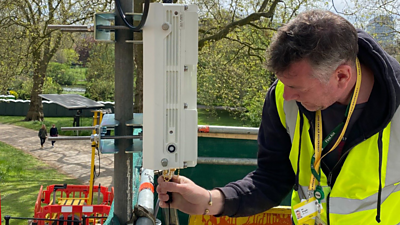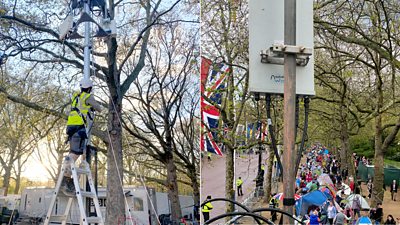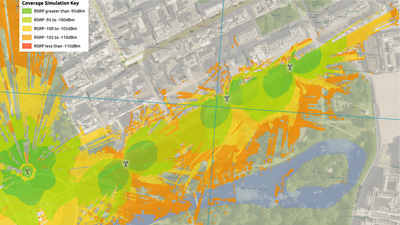This week the world is focused on The Mall in central London for the Coronation of King Charles III and Camilla, the Queen Consort. The world’s media outlets are here, and as I write this on Friday afternoon the crowds are starting to build.
Over recent years news crews have increasingly relied on mobile networks to get pictures from the heart of the action, they offer a great way to get to places that you just can’t reach with a satellite truck or cable. This means that there is computer hardware and kit available to broadcast from anywhere you can get a mobile signal. While this is OK most of the time, at big events the large mobile networks can get saturated with data very quickly as everyone tries to upload content to social media and journalists compete to send their pictures back to news channels.

Update:
September 2023 - Awards recognition for this Coronation trial!
The pop-up non-public 5G network trial for the Coronation by our 5G remote production team has - the broadcast technology industry's showcase for innovation which "[pushes] the boundaries of live and linear content creation and delivery."
The technical write up of the operational trial outlined in this article won the Best Technical Paper Award for 大象传媒 R&D's Mark Waddell, Ian Wagdin and David Butler, alongside trial partners Sam Yoffe, Kenny Barlee, Douglas Allan, Malcolm Brew, and Robert Stewart from the University of Strathclyde/Neutral Wireless.
The same team went on to also win IBC's Content Creation Innovation Award with partners from 大象传媒 News, LiveU, Sony, Haivision, Amarisoft, AW2S and Alpha Wireless.
April 2024 - Another win for 5G at the Coronation
The paper about the trial also .
At large events the mobile network operators can add capacity, but this is aimed at their customers and is generally spread over a wide area. This means that broadcasters cannot rely on this provision when they most need it; so must use other technologies to support their output leaving all the kit that supports news contribution unused.
大象传媒 News approached 大象传媒 Research & Development earlier this year following our successful trial of 5G Non-Public Networks (NPN) at the Commonwealth Games last year and asked if we could help solve this issue. The challenge was a big one - could we provide a private 5G network that was available for the days leading up to the event and during the Coronation itself? We wanted high uplink capacity over a large area which we could offer to news broadcasters from around the world. It has led to what is the largest temporary private 5G network of its kind ever deployed.

While we have trialled and tested smaller scale networks previously; this has been to support only 1 or 2 cameras, but we knew this would be a much larger challenge. We planned to support up to 30 devices all streaming large data rate video from any point along The Mall. For this we partnered with who specialise in 5G NPN and who we have worked with previously on our 5G Rural First project on Orkney.

One of the challenges of streaming lots of professional video is that you need a high capacity in your uplink. Most public networks are designed for their subscribers to download content. The only way we could deploy a network to support the amount of traffic was to use for shared access and separate from the public networks. Working with Ofcom we have been able to secure 80 MHz of radio capacity centred on 3855MHz, and with Neutral Wireless we looked at the best options to deploy cells that would cover the whole of The Mall.

We have deployed eight cells all with very low transmit power but high receive capability. This provides reliable and constant coverage from Buckingham Palace to Admiralty Arch. Using the mobile bonding devices such as with 5G modems and dedicated sims we have been able to move traffic away from the public networks and onto our private network. This traffic is then backhauled over fibre to Broadcasting House where it meets the internet and from there to whichever broadcaster is connected. The beauty of this system is that for operators and broadcasters the workflow is pretty much the same as they use every day, but we can be confident that their units will work no matter how busy the public network becomes. We now have over 60 devices connected from multiple broadcasters right around the world.
Of course, this is R&D so the challenge of deploying one network was not quite enough. We have also been looking at high capacity, low latency networks that can deliver UHD HDR pictures with bidirectional control. Working alongside Sony we also have two cameras operating on a separate cell in front of Buckingham Palace that will help us understand how these networks may be used in the future.
Related links
- -
- 大象传媒 R&D - All of our articles on 4G and 5G including:
- 大象传媒 R&D - Broadcasting Over 5G - Delivering Live Radio to Orkney
- 大象传媒 R&D - 4G & 5G Broadcast
- 大象传媒 News - 5G: Launch of UK's Next Generation Mobile Network
- 大象传媒 R&D - TV Over Mobile Networks - 大象传媒 R&D at the 3GPP
- 大象传媒 R&D - 5G-Xcast
- 大象传媒 R&D - 5G Trials - Streaming AR and VR Experiences on Mobile
- 大象传媒 R&D - 5G Smart Tourism Trial at the Roman Baths
- 大象传媒 R&D - New Content Experiences over 5G Fixed Wireless Access
- 大象传媒 R&D - New Audience Experiences for Mobile Devices
- 大象传媒 R&D - Building our own 5G Broadcast Modem
- 大象传媒 R&D - Broadcast Wi-Fi
